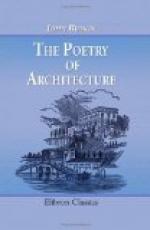145. Thus much for the mere effect on the eye. Of correspondence with national character, we have shown that we must not be disappointed, if we find little in the villa. The unfrequency of windows in the body of the building is partly attributed to the climate; but the total exclusion of light from some parts, as the base of the central tower, carries our thoughts back to the ancient system of Italian life, when every man’s home had its dark, secret places, the abodes of his worst passions; whose shadows were alone intrusted with the motion of his thoughts; whose walls became the whited sepulchers of crime; whose echoes were never stirred except by such words as they dared not repeat;[22] from which the rod of power, or the dagger of passion, came forth invisible; before whose stillness princes grew pale, as their fates were prophesied or fulfilled by the horoscope or the hemlock; and nations, as the whisper of anarchy or of heresy was avenged by the opening of the low doors, through which those who entered returned not.
[Footnote 22: Shelley has caught the feeling finely:—“The house is penetrated to its corners by the peeping insolence of the day. When the time comes the crickets shall not see me.”—Cenci [Act II. scene I, quoted from memory.]]
146. The mind of the Italian, sweet and smiling in its operations, deep and silent in its emotions, was thus, in some degree, typified by those abodes into which he was wont to retire from the tumult and wrath of life, to cherish or to gratify the passions which its struggles had excited; abodes which now gleam brightly and purely among the azure mountains, and by the sapphire sea, but whose stones are dropped with blood; whose vaults are black with the memory of guilt and grief unpunished and unavenged, and by whose walls the traveler hastens fearfully, when the sun has set, lest he should hear, awakening again through the horror of their chambers, the faint wail of the children of Ugolino,[23] the ominous alarm of Bonatti, or the long low cry of her who perished at Coll’ Alto.
OXFORD, July, 1838.
[Footnote 23: Ugolino; Dante, Inferno xxxiii. Guido Bonatti, the astrologer of Forli, Inferno xx., 118. The lady who perished at Coll’ Alto, i.e. the higher part of Colle de Val d’Elsa, between Siena and Volterra—was Sapia; Purgatorio, xiii. 100-154.]
IV.
THE LOWLAND VILLA—ENGLAND.
147. Although, as we have frequently observed, our chief object in these papers is, to discover the connection existing between national architecture and character, and therefore is one leading us rather to the investigation of what is, than of what ought to be, we yet consider that the subject would be imperfectly treated, if we did not, at the conclusion of the consideration of each particular rank of building, endeavor to apply such principles as may have been demonstrated to the




